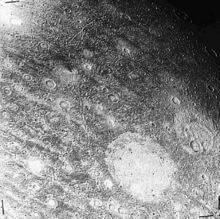Palimpsest (planetary astronomy)
From Wikipedia, the free encyclopedia

A palimpsest, in planetary astronomy, is an ancient crater on an icy moon of the outer Solar System whose relief has disappeared due to creep of the icy surface ("viscous relaxation") or subsequent cryovolcanic outpourings, leaving a circular albedo feature, perhaps with a "ghost" of a rim. Icy surfaces of natural satellites like Callisto and Ganymede preserve hints of their history in these rings. A typical example is Memphis Facula on Ganymede, a 340 km wide palimpsest.
See also
References
- Harland, D. M. (2000-11-10). Jupiter Odyssey (1st ed.). Springer Praxis. pp. 448 (see pp. 136–137). ISBN 978-1-85233-301-0. OCLC 44461919.
This article is issued from Wikipedia. The text is available under the Creative Commons Attribution/Share Alike; additional terms may apply for the media files.